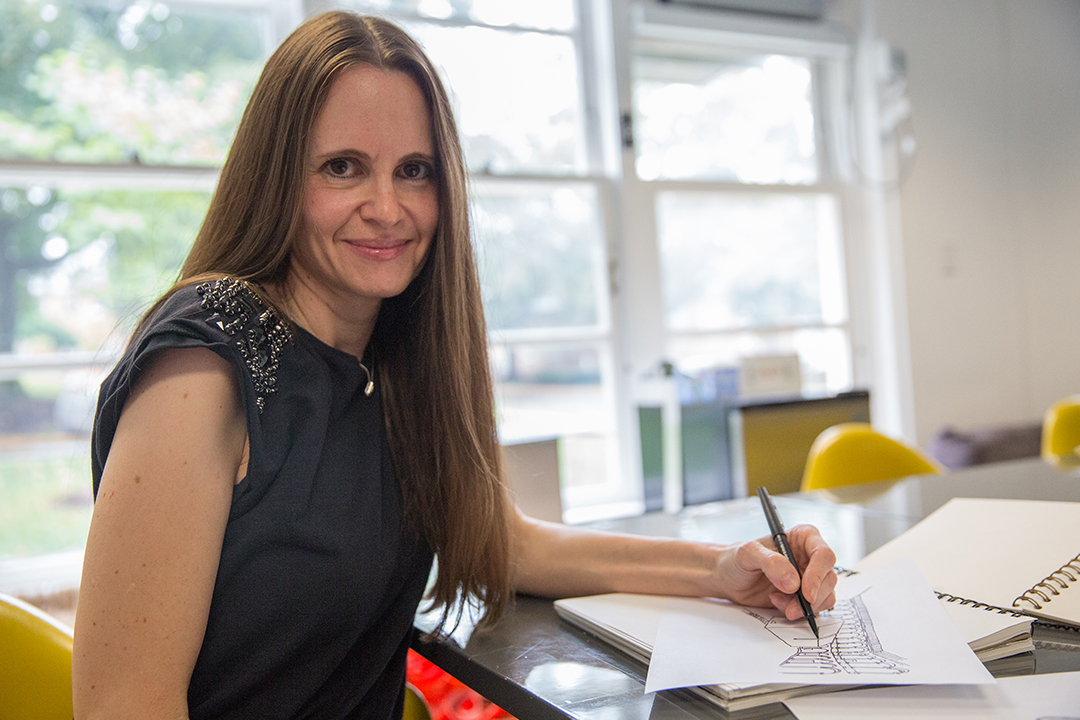By John DiConsiglio
It’s the dirty secret of design in the digital age: Today’s architects spend many more hours laboring over computer screens than sketchbooks. Hand-drawings, the architect’s primary tool for expression since the Renaissance, have largely been replaced by digital renderings. With sophisticated software like AutoCAD and Revit, designers can now instantly point and click their way to illustrations with photo-like precision. Indeed, in the face of a technology onslaught, sketching seems so perilously close to obsolete that the Yale School of Architecture hosted a symposium entitled “Is Drawing Dead?”
But ask Stephanie Travis, associate professor and director of the Interior Architecture and Design Program, and she’ll insist reports of drawing’s demise have been greatly exaggerated. Step into her classrooms and studios, and you’ll see more than a few students clutching pens, markers and even crayons, scribbling design concepts on sketchpads.
“Students are always surprised at how much our curriculum emphasizes drawing,” she said. “But no matter what anyone tells you, sketching is still essential for developing the next generation of designers—and it always will be.”
Through her classes and her new book Sketching for Architecture + Interior Design (Laurence King Publishing, 2015), Travis is on a mission to revive the art of sketching and give students raised on computers the confidence to pick up a pen. A hands-on book, Sketching includes 45 step-by-step exercises—complete with Travis’ own illustrations—that guide aspiring designers through outlines of furniture, interiors, complex building exteriors and cityscapes. Along the way, Travis includes instructions on essential design topics such as perspective, scale, composition and shading. By books end, she hopes readers—from architectural students to professionals sharpening their skills—will be bitten by the sketch bug.
“Once you get into sketching, it becomes not just a powerful career tool but also a lifelong passion,” she said.
Far from archaic, the ability to convey abstract design concepts with hand-drawn sketches is a vital part of the creative process, Travis said. Not only does drawing hone budding designers’ skills and help them establish a personal style, but architectural and design firms still look for strong sketchers. Sketching, according to Travis, remains the most fluent and unhindered way to transmit a designer’s vision to the world—whether while presenting rough draft ideas to their bosses or explaining concepts to their clients.
“There’s something about a pencil and pad that awakens your senses and expands the flow of creativity,” Travis said. “Sketching allows you to explore design objects more deeply, to see them more carefully. Sketchers have a visual dictionary in their head that’s as important to their career as anything they do on a computer.”
Generation Now!
For Travis, pitting hand-drawing against computer-generated imagery is a misleading debate. An architect should have both skills in her toolbox. She doesn’t deny that computer drafting now dominates the professional design world for its ease, speed and perfect detail. “It saves time and money in an architect’s daily work,” she said. “You would be crazy if you didn’t take advantage of the ability to make changes quickly rather than having to erase or redraw everything time and again.” Digital designs are also far easier to integrate with construction contractors, mechanical engineers and plumbers on large-scale projects, but “I wouldn’t want to build a skyscraper based on a hand sketch,” Travis said.
Still, in introductory sketching classes she’s taught, Travis has seen students who are extremely adept at creating computer imagery, but often lack confidence in their freehand talents. “This is a generation that has grown up with the computer,” she said. “But their laptops are also a crutch. Many simply do not have basic sketching skills.”
Ayelet Oser, MFA ’14, had little faith in what she called her “laughable” sketching abilities until she took three classes with Travis, including a 2013 study abroad sketching tour of London. Travis’ technique of breaking down sketching steps into manageable pieces—from correctable pencil designs to pen drawings that revealed every misstep and change of course—encouraged Oser to refine her personal style. “That’s where I developed my sketching hand,” she said.
In her book and her classes, Travis encourages students to view sketching as “a tool for seeing.” Focusing intently on an ordinary object like a table or chair, Travis directs them to draw what they see—not the features they associate with a chair, but the actual concrete object in front of them. “They know what a chair looks like, but they’ve never really looked at it before, at its perspective, its composition, the way the light hits it.” Travis stresses to novice sketchers that the final product isn’t as important as the journey they took to get there—a hard concept for grade-hungry students to embrace. “I have to reprogram them,” she said. “The computer is fast; it’s all about perfectionism. Students understand that. Sketching is slow. It makes you pause and scrutinize. You cross things out and start over. That takes more time to comprehend.” Or as Oser put it, “Stephanie made it clear that it was OK to make mistakes.”
Today, Oser is a designer with the prestigious Washington, D.C. firm HapstakDemetriou. Specializing in hospitality design, Oser creates concepts for restaurants, markets and hotels. “It’s exactly what I’ve always wanted to do,” she said. During her first interview, her future employers were impressed by her sketch-heavy portfolio. “They said they didn’t see that skill-set in many candidates,” she recalled. “That made me smile and think about Stephanie.”


